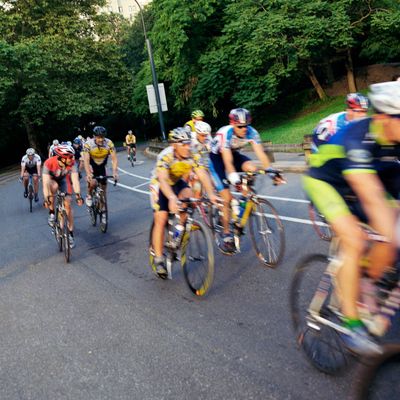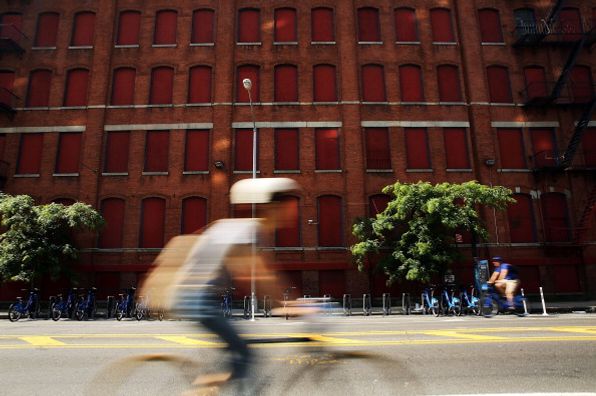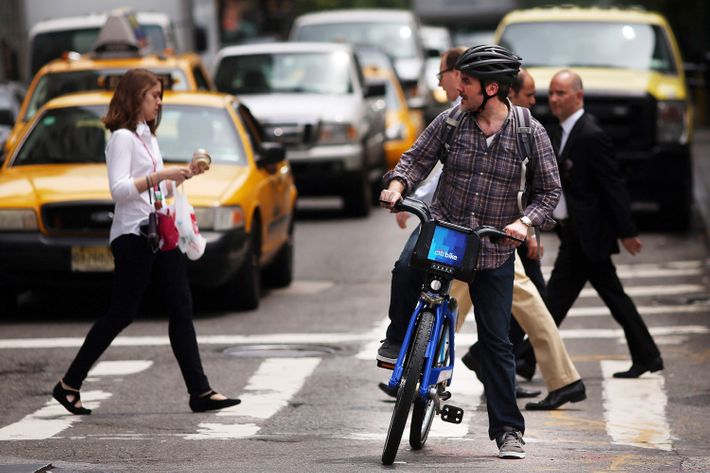
When citizens of the internet get annoyed by boorish plutocrats, sexually rapacious entertainers, or lion-hunting dentists, they respond with a blowtorch of outrage. Out in the streets of an actual city, we have fewer weapons: just a hollered insult, or a rude gesture, maybe, unless an altercation turns appallingly violent. I can’t be the only New Yorker who has longed for a harmless but effective smartphone-based shame dispenser to deal with everyday misbehavior. Can we figure out a way to post the license plate of every crosswalk-violating SUV? Bombard the owners of loud dogs with voice mails of agonized howling? Beam an anonymous message onto the screen of the guy who’s too obsessed with Angry Birds to move away from the subway doors? Surely these correctives, administered by a large-enough force of civility vigilantes, would encourage everyone to follow the rules?
Lately, I’ve been itching to launch a campaign of shame against a subgroup of bikers who regularly provoke explosive rage. Even as the city is slowly reshaping itself to meet their needs, some hotshot bikers still act like renegades. Packed into elastic outfits emblazoned with corporate logos, they assume an air of counterculture superiority. They oppose cars yet share the driver’s fantasy: miles of smooth, unpeopled asphalt ribboning toward the horizon, allowing maximum speed.

I’m a biker, too. I love pistoning along, feeling the strain in my thighs and the road slipping quietly beneath my wheels. But you can’t get the city to yourself just by pretending there’s no one else in it. When I bike in the most congested parts of the city, I yield at pedestrian crossings — and get cursed at by two-wheeled tailgaters who streak by me in a blaze of fury. I slow down near the Boat Basin in Riverside Park, conscious that a once-peaceful area where toddlers could safely gaze at ducks and old couples could shuffle arm-in-arm has now become a bike arterial. Here, too, commuters slalom through, supremely indifferent to the fear they cause. Bikers don’t perceive speed the way pedestrians do. Fifteen miles per hour feels moderate if you’re the one clocking that pace, reckless if someone else flits silently past. Space is elastic, too. A biker can shoot through a five-foot gap between slow-moving objects without a drop of adrenaline, but the startled pedestrians on either side will feel their pulse shoot up. What we have here is an anxiety differential.
The question, as always in cases of antisocial behavior, is: Are they outliers and loners, or representatives of an aggressive subculture? Paul Steely White, executive director of the advocacy group Transportation Alternatives, shrugs off “Lycra louts” as an ineradicable population of jerks who happen to ride bikes. But a lot of pedestrians believe it’s the bike that makes the rider — or, rather, that years of effective bike advocacy have stoked their sense of entitlement. One guy barreled toward a knot of pedestrians on a narrow park path and, when I asked him to slow down, shot past, then circled back to give me a physics lesson, irrelevantly explaining why bicycles are safer than cars. Sure they are, which is why bikers and pedestrians should make natural allies instead of opposing factions in a low-grade civil war. After all, some of us who walk in the morning will cycle in the afternoon.
White and other advocates rightly want to keep the focus of outrage squarely on cavalier drivers whose carelessness or arrogance can be lethal. But risk-loving, sanctimonious speed-demons are also obstacles to a truly bikeable city. New York is only about a quarter of the way there. True, in under a decade, the Department of Transportation has thrown a 400-mile bicycle network across the map. A few of the lanes are state-of-the-art mini-highways, divided from traffic and pedestrians by strips of concrete or rows of parked cars. Central Park and Prospect Park have been mostly closed to cars. Queens Boulevard is getting a $100 million pedestrian-friendly makeover, with a new bike lane as its spine. Citi Bike has become an essential in thousands of daily routines.
But at times this rosy new reality feels as fragile as a fading stripe of paint on asphalt, which is all there is to many bike lanes. Most of Queens remains a cyclist’s purgatory. Riding through midtown still means threading among jostling cabs and vans and buses, guzzling carbon monoxide. Crossing a major intersection is often a high-adrenaline sport. Bikers know the value of momentum, and at a time when the subway is falling apart and the mayor is battling Uber, unrolling more safe and comfortable bike lanes at a steady clip matters more than ever. Once they were considered trivial luxuries. Now, as public advocate Letitia James wrote to transportation commissioner Polly Trottenberg recently: “Bicycle lanes should be the default option when a street is up for a redesign.”
One day I’d like to see the streets fill with the full spectrum of riders: seniors, kids, wobbly tourists, shoppers with handlebar baskets, short-haul commuters who picked up an old clunker on Craigslist, and all those who right now believe that you’d have to be suicidal to bike in the city. I had hoped Citi Bike would do the trick, but so far it appeals to a disappointingly narrow demographic: disproportionately white, male, and young. The only way to make everyone else feel safer is to physically separate bikers from pedestrians and cars. “There’s still a lot of friction on our streets, but look at Eighth and Ninth Avenues: Those were the Wild West,” White says. “Now, with the protected bike lane, pedestrian refuges, and narrower car lanes, it’s a more predictable and rational street, and it’s saner and less fractious.”

So, it pains me to say this, but the more strategically effective alternative to turning hotshot riders into pariahs is to give them exactly what they want. Protected bike lanes aren’t a sop to undeserving bikers; they’re a crucial element in the long-term project to civilize the streets for everyone who needs to use them. But I’d still enjoy a pillorying or two.






























